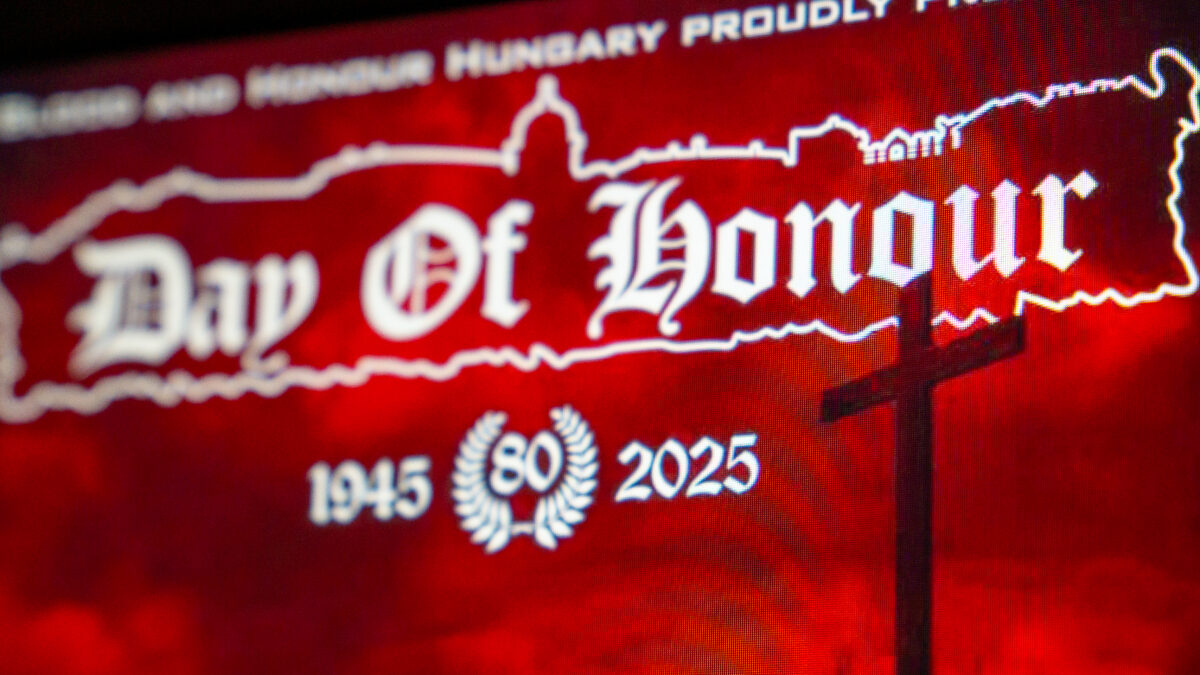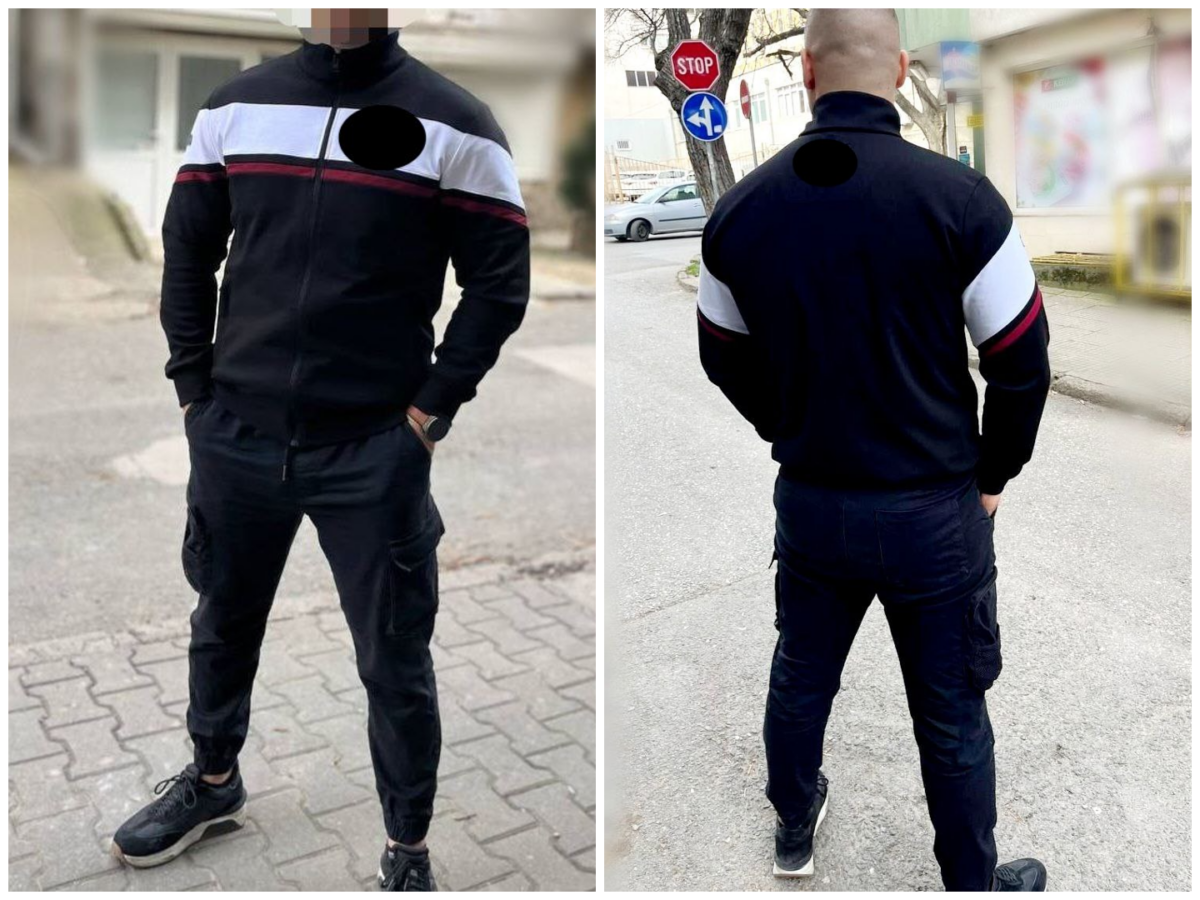The Man in the Matching Uniform: Investigating a Rusich Atrocity in Syria
This investigation contains graphic images and footage as well as references to killing and mutilation that some readers might find distressing.
An image analysis by Bellingcat shows an infamous Russian neo-Nazi with ties to the controversial paramilitary Wagner Group may be involved in the staging of a photograph showing a man holding a severed head in Syria.
Alexey Milchakov oversaw the far-right Rusich Group, described by experts as a ‘contingent‘ of Wagner, the armed group that staged a rebellion against Russian authorities last year. Rusich has previously been implicated in war crimes in Syria and Ukraine, including torture and mutilation. According to Russian newspaper Kommersant, Milchakov has at various times shared command of Rusich with Yan Petrovsky. Both men are subject to sanctions by the US, EU and other governments.
On February 10, 2020, the Telegram channel of a prominent Russian military blogger posted an image of a man in uniform holding a severed head. Behind him was another severed head and a backdrop of hilly, uncultivated terrain as far as the eye could see, smoke rising from the horizon. Then, on January 18, nearly four years after the original post, Rusich’s official Telegram channel posted the same image before deleting it shortly thereafter.
The face of the man holding the head had been censored in the image, which may have been taken in 2017. Although references to an unobscured image exist on social media, Bellingcat has yet to discover it. But by using open source research methods, even the obscured version of the image can shed some light on the identity of this uniformed man in the hills outside Palmyra.
Since the photo was initially uploaded, further imagery of Rusich fighters in Syria has surfaced, providing further reference material against which to compare the image. We used the arrangement of camouflage patterns on the man’s uniform to conclude that his uniform is the same as that worn by Milchakov in multiple photographs seen on his social media accounts.
It is, therefore, possible that the man holding the severed head is Milchakov himself, who is also known as ‘Fritz’ and ‘Serb’.
This would not be the first time that Wagner or Wagner-affiliated soldiers have committed such acts in Syria.
In a statement posted to their Telegram channel after Bellingcat reached out for comment, Rusich wrote, “the acts depicted do not constitute a war crime because a) we’re not military and b) we were happy to do it.”
Rusich did not directly address whether Milchakov was the man in the image or involved in the incident, though without any evidence or explanation suggested it could be a far right Belarusian national who fought alongside Ukrainian militants in the Donbas war.
Bellingcat attempted to contact Milchakov via his VK account but received no response.
This image was published after a November 2019 article by the Russian newspaper Novaya Gazeta identified a former Russian police officer as one of a group of Wagner mercenaries who recorded themselves torturing and mutilating a Syrian man in June 2017. The article and a follow-up from April 2020 are crucial pieces of evidence of atrocities by Wagner mercenaries in the country, though no charges have ever been filed. (Caution: these links contain graphic images of torture and mutilation.)
Meanwhile, Rusich and Wagner Telegram channels have on several occasions posted other redacted images showing armed men wearing the same uniform as that worn by the man who held up the severed head. These were taken in the same area of Syria as the aforementioned beheading image.
Severed heads and other images of extreme violence feature heavily in internal and external propaganda in Wagner’s online culture. In Syria, photos of heads on stakes and skulls were widely shared and, in some cases, turned into alternate logos for Reverse Side of the Medal (RSOTM), a mercenary culture brand. In Russia’s current war against Ukraine, Wagner fighters and their supporters have distributed similar imagery.
The Story of the Photo
The Telegram channel that first posted the image of the man holding the head belonged to Maxim Fomin, a Russian military blogger also known as Vladlen Tatarsky.
Fomin fought as a member of Russian-backed separatists in Ukraine’s Luhansk region, and was a central personality in the Russian mercenary community until he was assassinated at an April 2023 event in St Petersburg featuring Russian propagandists.


The image could be geolocated to an area near Palmyra in the Homs province of Syria at coordinates (34.8766944, 37.9440556).
This location is just five and a half kilometres northeast from where the aforementioned torture and beheading of a Syrian man at the hands of Wagner mercenaries took place in early 2017.
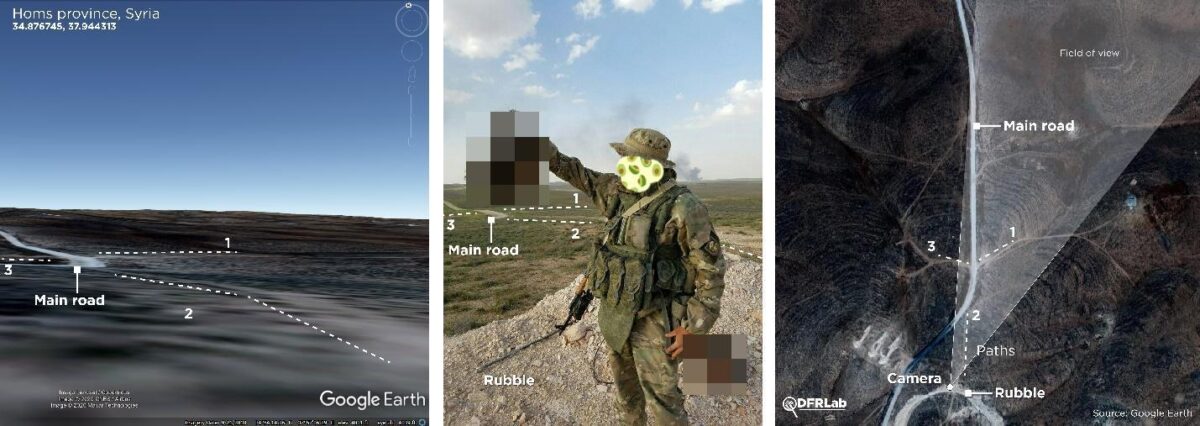
Visual features of the background with satellite imagery (right), allowed for the geolocation of image. Using Google’s terrain elevation data, we were able to match the image with a ground-view perspective on Google Earth and found that all key details matched. These details included, but were not limited to, the specific bends in the road, the obscuring of other paths by hill curvature, and a T junction visible far in the background.
This location is one of several strategic hilltops in the area, which was a hotspot in the fight to retake Palmyra and its energy resources from the Islamic State in late 2016. It was also 30 kilometres from this location that Alexey Milchakov was pictured in a swimming pool in Palmyra in a November 2017 article by Russian news website Fontanka about the presence of Rusich in Syria.
But when was the image taken?
Chronolocation by a Fire on the Horizon
The image shared on Fomin’s Telegram channel in 2020 contained no metadata, meaning that it could not be precisely chronolocated. However, the plume of smoke on the horizon offers a potentially useful clue — it might be the consequence of an event which could have been reported about in more detail.
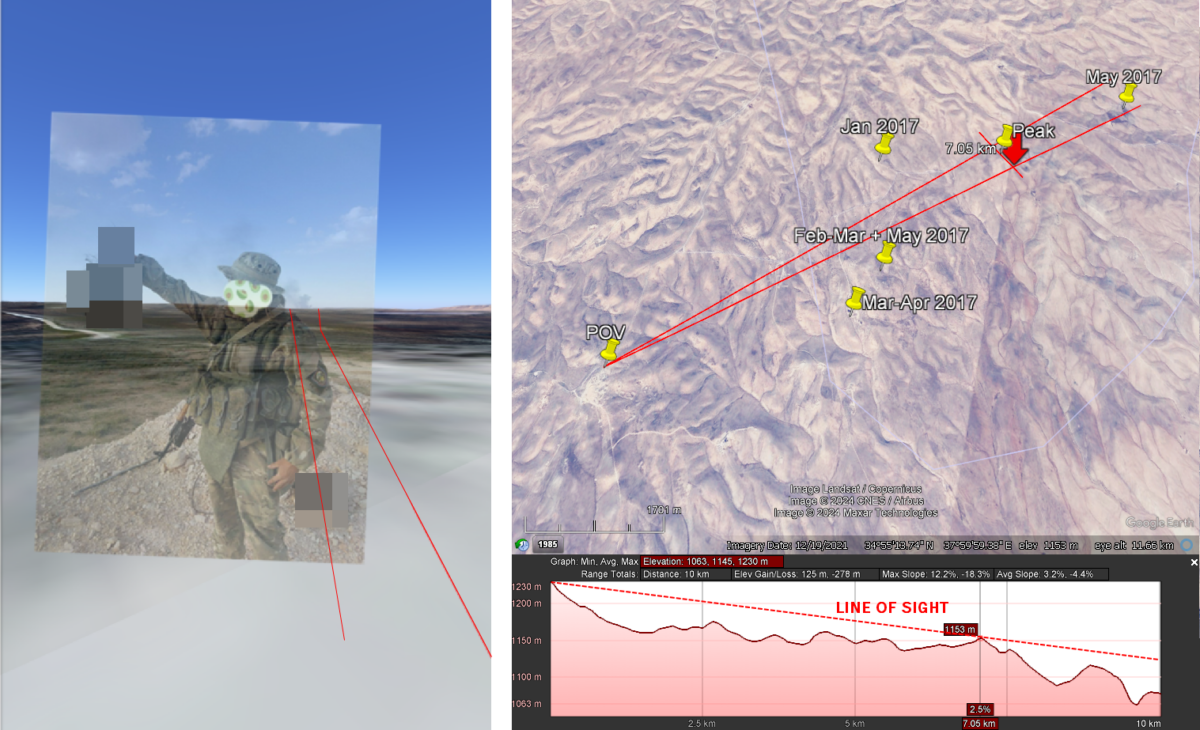
To find a possible source for the smoke, lines were drawn in the direction of the smoke from the camera’s point of view. The source image was overlaid onto the panorama view in Google Earth Pro, with both lines were placed on either side of the smoke with ample room to allow for error.
As the bottom of the plume of smoke was obscured by a peak on the horizon.
Google Earth Pro’s elevation profile tool was used to determine where the furthest visible hill would lie along these lines, since the smoke appeared to emanate from behind it. Once this peak was identified, at the coordinates (34.9372342194, 38.0198114785) the search area beyond it was narrowed down.
We searched satellite imagery of this area for 2016, 2017 and 2018 — years where Russian armed forces and Russian paramilitary activity was reported in this general area of Syria.
Planet satellite imagery from May 9, 2017 showed a large active fire within the search area of interest.
The satellite image below includes the two red lines denoting our field of interest, roughly transposed from the Google Earth Pro overlay on the image of the man holding the severed head. The red bar intersecting them denotes the elevated terrain seen on the horizon from the perspective of the photographer. We knew that the fire would be beyond this line.

NASA FIRMS, a tool which tracks anomalous heat signatures using satellite data, also recorded two fires burning in this location on May 1, 2017. While two red cubes can be seen closer to the vantage point of the cameraman, we know that these are not the fires in question as they are in front of the peak so would have been visible in the photograph.
Publicly available Sentinel Hub satellite imagery shows that the fire continued to burn in this location on May 8. The long duration of this intense blaze, as well as the black stains in the immediate area, suggest that an oil source caught fire.
This fire is therefore an excellent candidate for the cause of the plume of smoke seen beyond the horizon in the photograph of the man holding the severed head. It means that there is a good possibility the photo was taken in early May 2017, about half a year before the aforementioned Fontanka article reported on Rusich’s presence in the area.
Marks on the ground observed on Landsat and Sentinel satellite images of this area around the same time suggest that smaller fires may have broken out within the area of interest outside this timeframe.
In posting the image, Fomin added the caption, “a typical Syrian volunteer speaks to his Yorick” in Russian, referencing the famous soliloquy in Shakespeare’s Hamlet in which the titular character ponders mortality while holding the skull of a dead court jester.
The “volunteer” in the image, however, was not Syrian but likely a Russian national. As Bellingcat has previously reported, Wagner’s social media channels have a track record of deliberately posting misleading information about their activities.
This includes the popular Wagner-affiliated account Reverse Side of the Medal (RSOTM), which reposted the image on their now-deleted Instagram page after Fomin’s Telegram post. In response, some users wrote comments claiming that they knew more about the context of the photo. These are highlighted in yellow in the screenshot below.
For example, the user ssg_west wrote “I’m serious, the photo is from the year [20]16. Holms.”
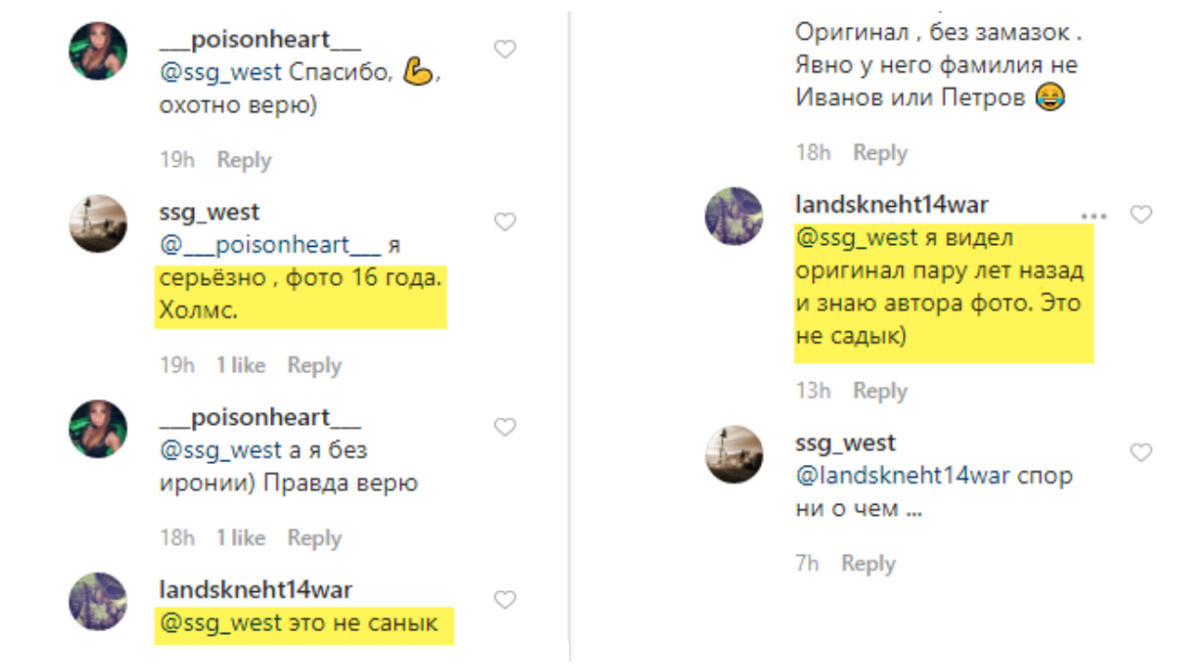
This is likely a typo for the Syrian city of Homs, as the Russian letters O and L are adjacent to each other on the Cyrillic keyboard layout. While the year is questionable, the location is broadly correct: the image was indeed within Syria’s Homs Governorate, meaning that this Russian-speaking individual either possessed geolocation skills or knew something about the context behind the image.
The user landskneht14war claimed to know that they knew the author of the photo, first writing the misspelt sentence “this is not a Sadyk” (a Russian slang term for soldiers in the pro-Assad Syrian Arab Army) then elaborating on it in an exchange with another user.
“I saw the original a couple of years ago and know the author of the photo. It’s not a Sadyk”, wrote landskneht14war.
The identity of the person who was beheaded is not known. Part of landskneht14war’s name may be a reference to the German-speaking mercenaries “Landsknechte” in the Holy Roman Empire, with 14 a possible reference to the white supremacist 14 words slogan. These clues suggest far-right beliefs that overlap with those of Rusich’s openly neo-Nazi members.
Further investigation of social media connections suggests that landskneht14war might be in a position to know more about the image.
When the author viewed Milchakov’s Instagram account in 2020, he found that it was followed by landskneht14war. At the time of publication, both accounts had been deleted.

That this account belonged to Milchakov could be established by the name “Yurievich Alexey”, which are Milchakov’s patronymic and first name. When this profile was inputted into one of several Telegram bots used by Bellingcat to aggregate leaked personal data, it returned further confirmation.
The phone number associated with the Instagram account was connected to further social media profiles belonging to Alexey Milchakov. It also produced his full name and date of birth.
The same number surfaced in leaked phonebook data, meaning the names by which mobile phone users have referred to this number in their contacts lists.
Among these phonebook entries were the names Alexey Yurievich, Milchakov, Serb and Fritsulya (a diminutive for ‘Frits’). As mentioned earlier, the latter are Milchakov’s battlefield nicknames.

James Gow, Professor of International Peace and Security and Codirector of the War Crimes Research Group at King’s College London, told Bellingcat that the image potentially shows violations of multiple war crimes statutes.
Among them, he explained, were the International Criminal Court (ICC) Statute and the International Committee of the Red Cross (ICRC) Canon of Customary International Law, both of which prohibit the mutilation of dead bodies.
Finding a Match
Since the face of the man in the image was obscured, an alternative method had to be used to identify him. For this reason, the author began to analyse the uniform during his tenure at the Atlantic Council’s Digital Forensic Research Lab (DFRLab).
While camouflage patterns are repetitive, the patterns themselves will vary in terms of where they are positioned on the uniform. This means that strips of fabric showing the same camouflage pattern will not necessarily be stitched together in the same way.
This is incredibly useful when attempting to identify an individual by comparing multiple articles of clothing, such as a jacket and trousers having the same stitching pattern. The image below demonstrates this principle. US soldiers from the 838th Military Police Company stand in formation wearing the same camouflage pattern.
However, on closer inspection there are some differences.
The flap on the breast pocket shown in the white boxes differs. While the camouflage pattern itself is clearly the same, the way that pattern is cut and stitched is not — individual splotches of brown, green and white are in different locations on the pockets.
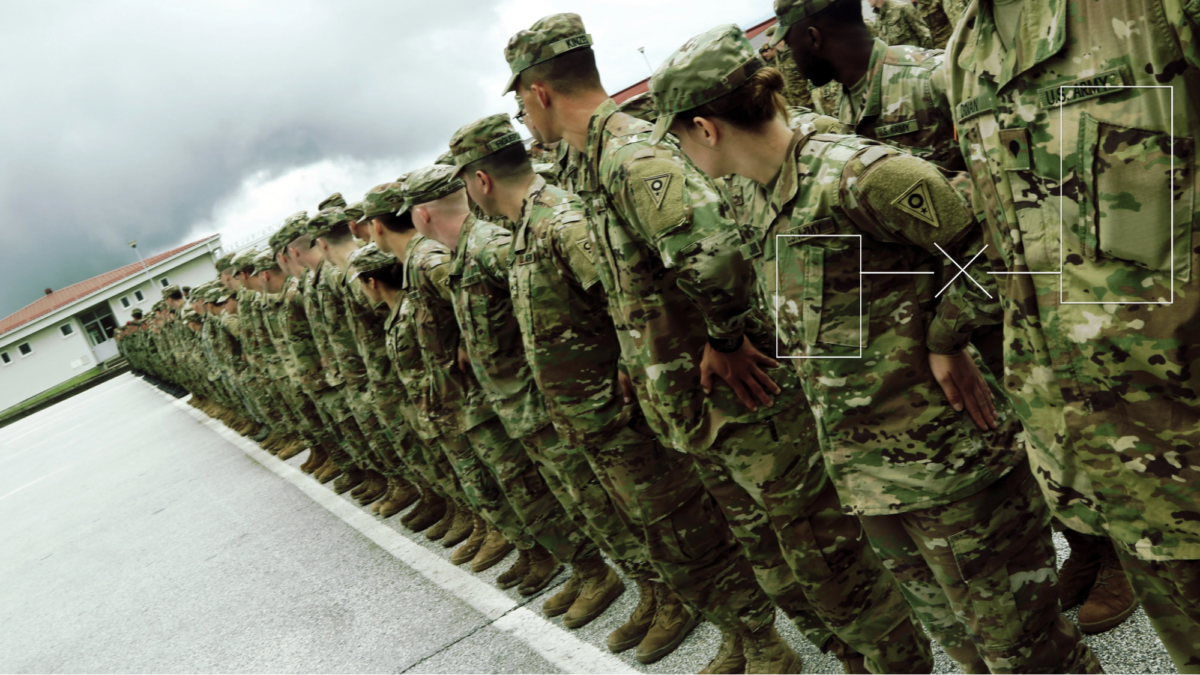
We can apply this principle to the photo of a man holding a severed head in Syria. This involves comparing the uniform to that seen in photographs taken from Milchakov’s account on VK, a Russian social media network, which contain extensive information about his military service.
This account, which has the username ‘Alexey Serb’, includes photos of Rusich flags and a paramilitary identity card from the ‘Luhansk People’s Republic’ in which Milchakov’s full name and patronymic are visible (archived images here).
The interactive graphic below cross-references individual points on Milchakov’s clothing. By hovering your cursor over areas of the uniform of the man holding the severed head, the illustration will highlight the corresponding areas of the same uniform in images of Milchakov.
Interactive graphic by Logan Williams
The man in the image who holds up the severed head wears a uniform with the popular “Multicam” styled camouflage pattern. There are four matches in the positioning of the camouflage pattern across three different parts of clothing (hat, smock, and pants).
For example, the left sleeve of the uniform of the man holding the severed head bears the badge of the 234th Guards Air Assault Regiment of the Russian Federation’s 76th Guards Air Assault Division, which Milchakov has been seen wearing frequently in photos posted to the aforementioned VK account.
Two black splotches can be seen on the hemming of the pocket facing inside his arm, directly to the left of the division’s badge. The pocket flap bears a thin brown line approximately one third of the way up. These indicate either that the pocket flap was either cut in precisely the same way from the camouflage fabric and that the pocket was hemmed using fabric in exactly the same position. Or, more plausibly, it indicates that the two uniforms are one and the same.
Due to the man’s stance, the badge on his right arm cannot be fully seen. However, the matching uniform worn by Milchakov bears a badge with the Rusich logo in that position.
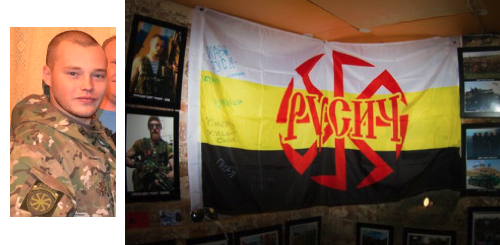
This factor, combined with the man’s appearance on Rusich’s social media posts, demonstrates that the man holding aloft the severed head was affiliated with Rusich.
There is a low chance that two identically stitched pieces of camouflage clothing may appear together, but a combination of three separate pieces of camouflaged clothing with the same pattern carries a far lower chance of duplication.
This indicates that the man holding the severed head wears Milchakov’s uniform and that he could indeed be Milchakov.
Bellingcat provided the images and analysis of the camouflage worn by Milchakov in this story to the Military Sciences Research Group at the Royal United Services Institute (RUSI) for independent assessment. Noting that the positioning of the pattern would be difficult to fake or accidentally duplicate, RUSI determined the methodology used to compare the camouflage pattern on the uniforms to be “viable”, the analysis of the images and pattern “thorough”, and the conclusion that the images show the same uniform “credible.”
“Most uniforms are unique because of the random assembly techniques used by most manufacturers,” said Guy Cramer, the CEO of camouflage manufacturer HyperStealth BioTechnology, which has supplied forces in the United States, Canada, Afghanistan, New Zealand and Mexico. He noted that some countries record the unique characteristics of uniforms at the point of assembly “to track individual restricted uniforms if that uniform is used in a crime or sold to a criminal organisation.”
Cramer said there is “a very slight chance” that the uniform came from a factory that cuts identical patterns using robotic cutters that trim the exact same parts from the exact same camouflage prints. “I’ve only seen one country do that with their uniforms and it wasn’t with Multicam,” he added.
Rusich on the March in Syria
This uniform identification also advances knowledge of other redacted images shared by Rusich, whose geolocation confirms a Rusich presence not far from the site of the beheading photo.
Rusich has shared an abundance of media from these operations in recent years; differences in gear visible across those media suggest the group carried out at least two separate tours there.
In 2020 the Norwegian media outlet NRK reported on the role of Rusich co-leader Yan Petrovsky and other far-right Russians with links to Norway, where Petrovsky once lived. Last December, Petrovsky was detained in Finland on suspicion of committing war crimes in eastern Ukraine, for which Kyiv has requested his extradition.
NRK also used commonalities across uniforms and gear to identify Petrovsky in photographs from Syria, where he admitted that his group had fought.
When asked by NRK about Rusich’s presence in Syria, Petrovsky said that the unit had “objectives” in the country. When further pressed about the nature of their presence in Palmyra specifically, Petrovsky simply responded “war”. (In their Telegram statement following Bellingcat’s request for comment, Rusich said Petrovsky “has nothing to do” with the photo of the man holding the severed head. His lawyer did not respond to a request for comment.)
In recent years, Rusich has posted images which show a man wearing the same uniform and equipment as the individual who held the severed head.
This uniform can be seen worn by the man on the right in following collage of two photos, which was posted to Rusich’s Telegram channel on December 8, 2022.
Both people in the images posed with the corpses of presumed ISIS fighters killed in battle. Bellingcat was unable to chronolocate or geolocate these photos.

A similar image collage was posted by Rusich in September 2022.
This time the man on the left wears the same uniform as the man who held the severed head.
Both photos could be easily geolocated – they were both taken in Syria, in the hills to the north-west of the city of Palmyra. The left image was taken at (34.7413187777, 37.9193291545) and the right at (34.6563923319, 38.1964929957), 27 kilometres apart on opposite sides of the same range of hills.

Source: Rusich / Telegram
Two more photos posted to VK by Rusich in June 2022 showed armed men in the same desert landscape near Palmyra, Syria.
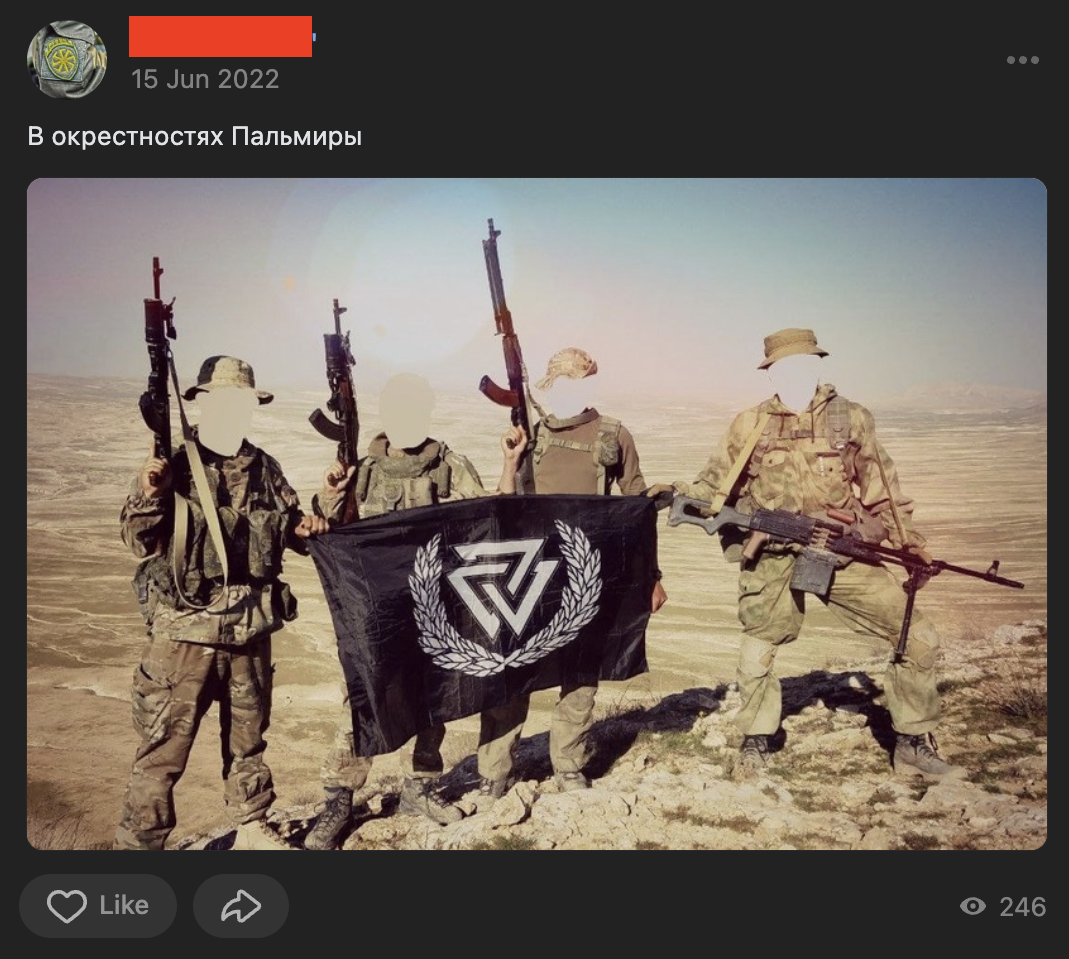
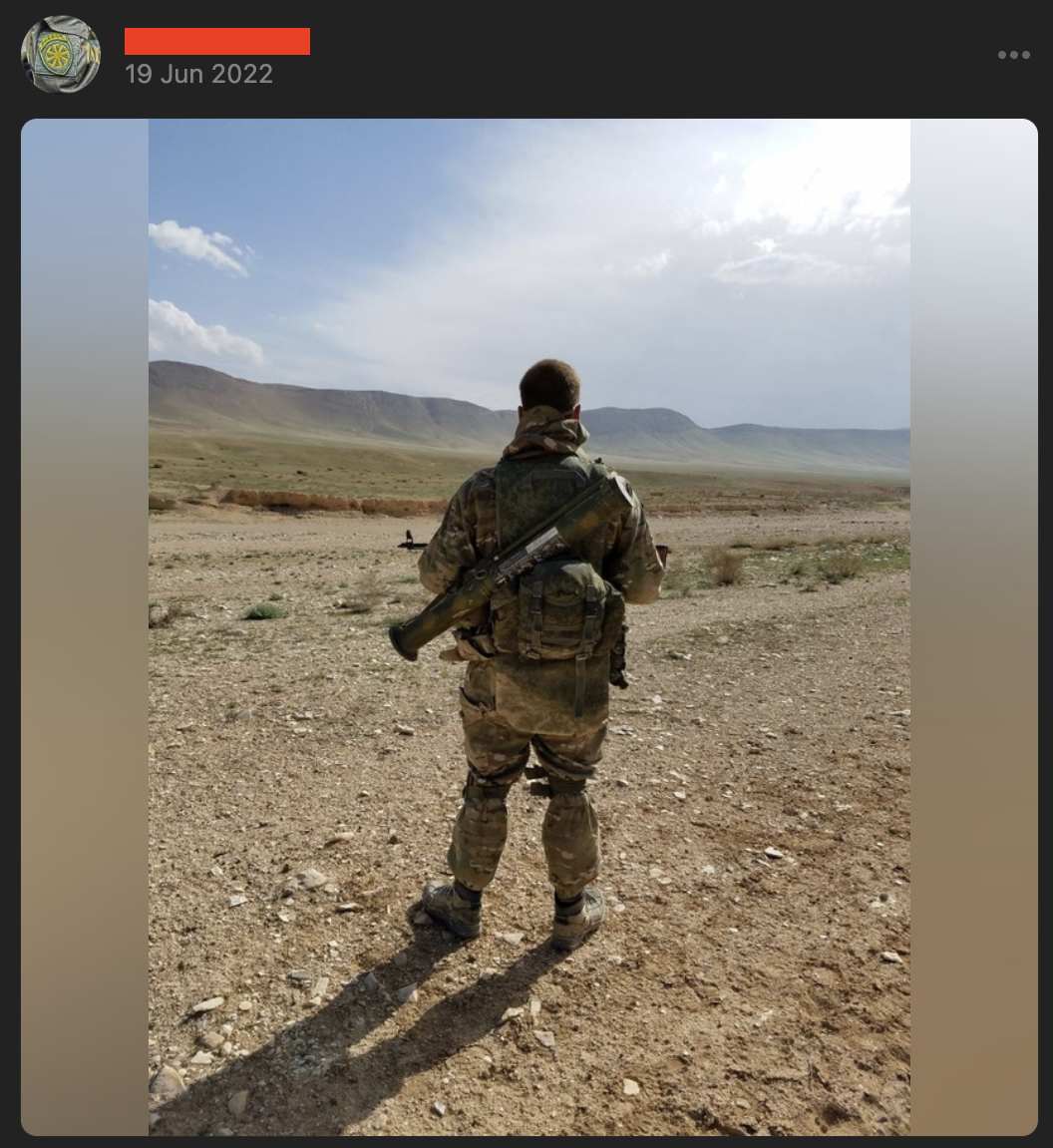
A closer inspection of several of these photos also reveals a close similarity with the positioning of the camouflage pattern on the uniform Milchakov wears in photos from his VK account:
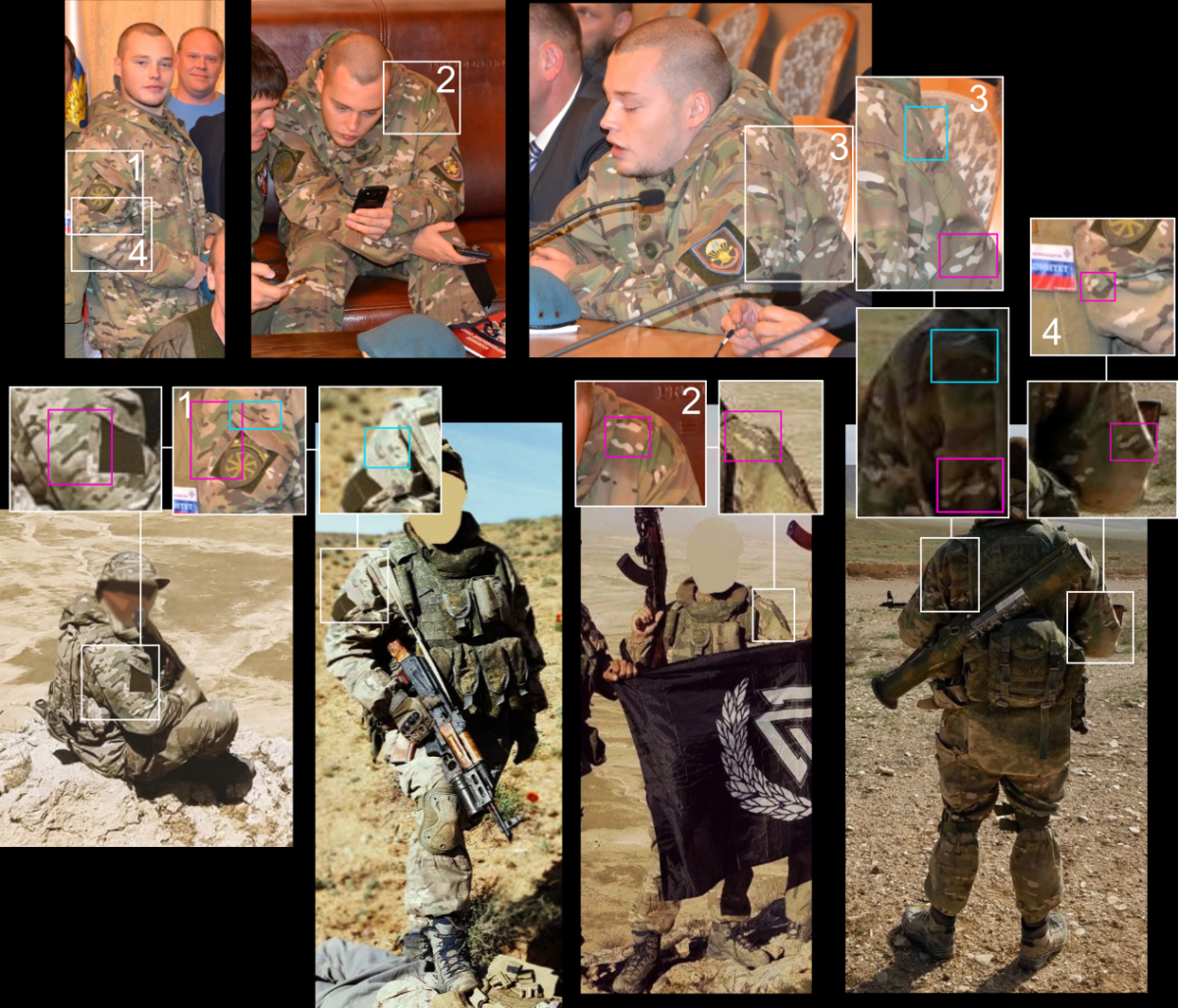
Moreover, three of these four images (photos one, three and five in the graphic below) could be geolocated close to each other in the same area of Syria. A further landscape image from the Rusich (photo six) Instagram account was taken in the same area, as were two photographs on which Fontanka and NRK reported in their work on Rusich (photos two and four):
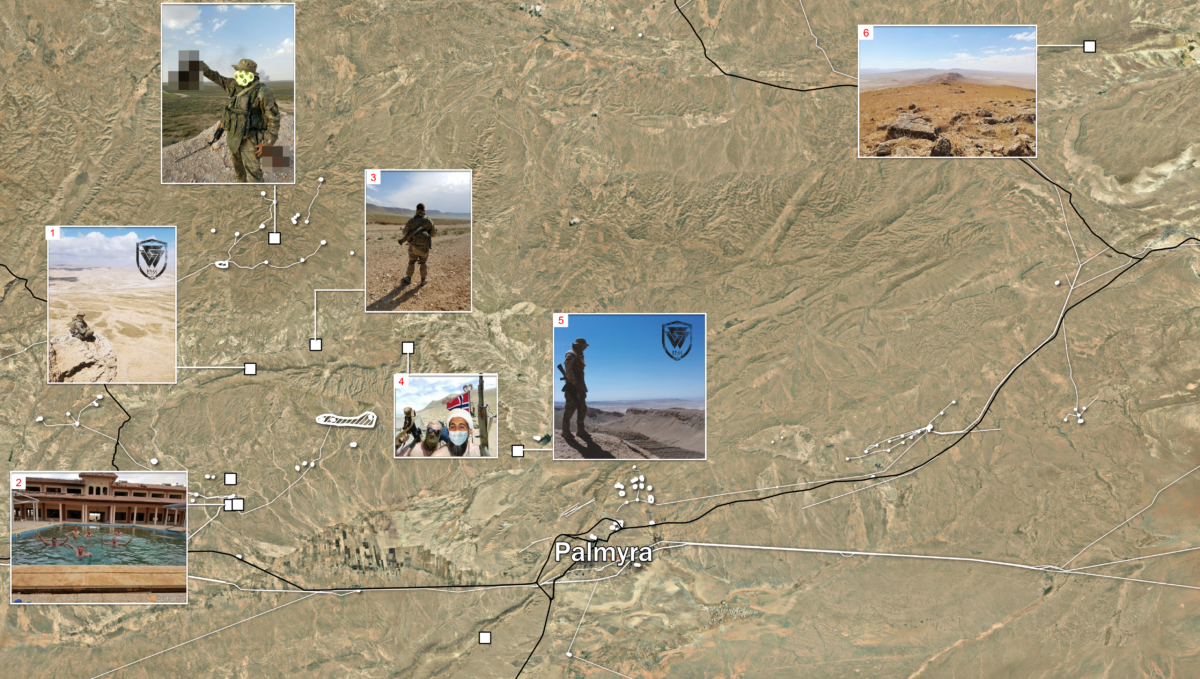
These similarities in camouflage patterns, as well as other gear, suggests that an individual wearing the same uniform as the man who held up the severed head had been active among Russian mercenaries in the landscapes north of Palmyra — an area where Milchakov was present.
The author would like to thank the DFR Lab’s editors and staff for their support on the initial stages of this research during a previous research position with the organisation

